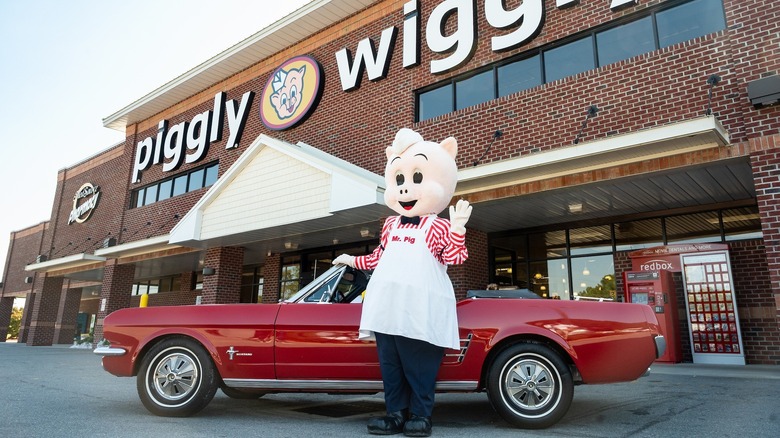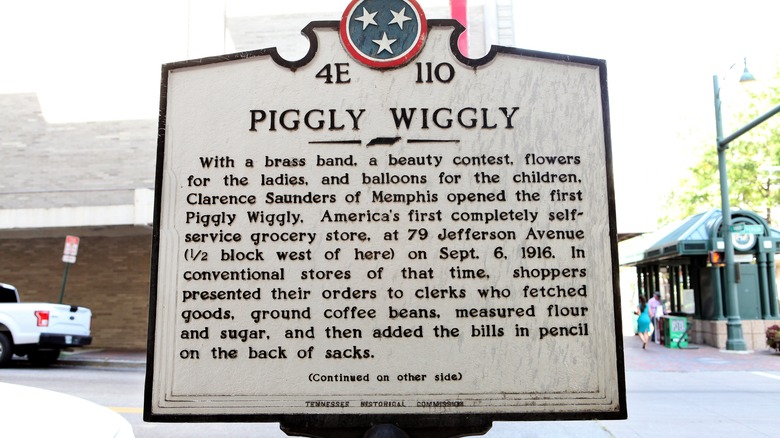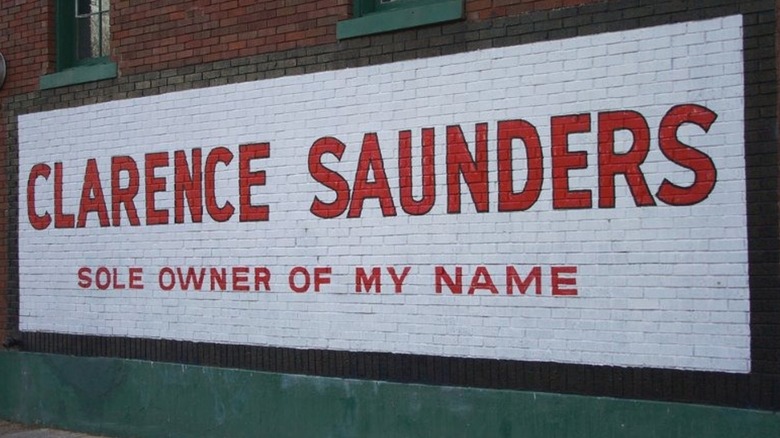The 100-Year Mystery Behind Piggly Wiggly Grocery Stores
Before self-checkouts, grocery shopping was a much more social affair. In the early 20th century, you couldn't go to the store to buy food without talking to a grocery clerk. Unlike cashiers who simply ring up your items then send you on your way, clerks took care of the shopping. Customers would hand over their shopping lists, then eventually be handed a bag full of the products they asked for. While some counters in modern-day supermarkets are still supervised by a clerk (like, say, the bakery), this "full-service" model gave way to the "self-service" one. (Ironically, today, the closest experience you can get to grocery shopping in the 1900s is probably Instacart.) Now, most people can walk into a store and grab everything themselves — sometimes without talking to another soul. And it's all thanks to a business with one of the strangest-sounding names to grace a grocery store sign: Piggly Wiggly.
The first self-service grocery store in the U.S. — and the predecessor for today's retailers — was founded by Clarence Saunders in Memphis, Tennessee, in 1916. Dissatisfied with clerk-based stores, which cost lots of both time and money, he came up with Piggly Wiggly, where customers would do their own shopping, originally with hand baskets and eventually with the first shopping carts. Piggly Wiggly quickly caught on, so Saunders franchised it. By 1922, there were 1,200 locations throughout the country.
Of course, the shockingly successful new approach to grocery shopping wasn't the oddest thing about Saunders' store; that would be its name. And over 100 years later, the mystery behind the origins of "Piggly Wiggly" still puzzles shoppers.
How did Piggly Wiggly get its name?
Over the years, there have been many explanations for the Piggly Wiggly name. And while the mystery has still never been solved, that hasn't stopped people from speculating. The store's website is even home to some speculation of its own: "One story says that, while riding a train, [founder Clarence Saunders] looked out his window and saw several little pigs struggling to get under a fence, which prompted him to think of the rhyme." Memphis historian Mike Freemen has taken a stab at the name's origins as well, giving some credit to this story. In his book "Clarence Saunders and the Founding of Piggly Wiggly," he suggests that it may have been mashed together from a combination of an old nursery rhyme that begins "Higgledy piggledy, my fat hen" and "Uncle Wiggily's Adventures," a children's story regularly featured in a local newspaper as a comic strip.
Of course, people thought to raise the issue with Saunders himself, and his answer usually suggested the name was intentionally odd. The Piggly Wiggly website claims that when asked about its meaning, he replied, "So people will ask that very question." According to The Tennessean, he said, "It took me two hours to find a name that was ridiculous enough." The point of Piggly Wiggly being called Piggly Wiggly simply seems to be that it's strange enough to talk about — and here we are, still talking about it over a century later.
Piggly Wiggly wasn't Saunders' only oddly named grocery store
Clarence Saunders was written out of Piggly Wiggly's history shortly after the franchise became successful. In 1923, the otherwise savvy businessman made some financial missteps involving his company's stock, losing ownership of the Piggly Wiggly empire. Distraught yet undeterred, Saunders set out to one-up himself and those who wrested away control of his stores, starting afresh.
If people thought Piggly Wiggly sounded funny, his second grocery chain was called something even weirder: the "Clarence Saunders: Sole Owner of My Name" stores, usually shortened to the Sole Owner stores. This self-aggrandizing name was supposedly inspired by copyright limitations and a bankruptcy judge, who told Saunders, "You, sir, own nothing. You are only the sole owner of your name" (via The Tennessean). The Sole Owner stores expanded on the Piggly Wiggly model: They were self-service but with the addition of specialty clerks who staffed meat and bakery counters. They were also wildly successful. Memphis Magazine wrote, "By 1927, he operated 220 stores in 15 states, with total sales approaching $25 million — an astonishing sum in those days." Unfortunately, the business fell victim to the Great Depression and was bankrupt by 1933.
But Saunders tried again, establishing yet another grocery store with a funky name in 1937: Keedoozle, which was half grocery store, half vending machine, and was based, apparently, on the phrase "key does all". The store adopted a fully automated approach to shopping for food, but its machine-based model ultimately failed. Perhaps it was too early for its time. After all, as Saunders' acumen for marketing and innovation shows, he was often on track to something attention-worthy — even if it was a little mystifying to everyone else.


